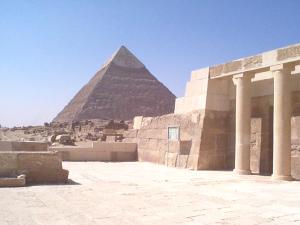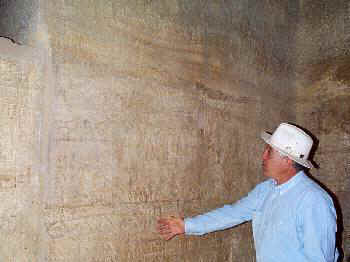 Egyptian
Tombs
Egyptian
Tombswhich are open to the public
Giza, Egypt
 Egyptian
Tombs
Egyptian
Tombs
which are open to the public
Giza, Egypt
Many tombs are being opened to the public, some for the first time. Here's some of the more recent tomb openings
Newly Opened Tombs:
We chose three new tombs to restore. The restoration involved making new ceiling and roofs for the structures, removing graffiti left by visitors, and restoring the inscriptions and paintings on the walls:
1. Seshem-Nefer
This tomb is located south of the Great Pyramid and is dated to Dynasty 6 of the Old Kingdom. Seshem-Nefer was the overseer of the two seats of the House of Life. He was also guardian of the king's secrets. The tomb is dated to the end of the Fifth Dynasty of the Old Kingdom. It is located to the southeast of the Great Pyramid, and it is one of the largest tombs at Giza. It is very special because contains both fimerary scenes and depictions of daily life. Of the loveliest scenes is a depiction of the offering bearers and a scene of the deceased and his wife hunting in a marsh. The entrance to the tomb is flanked by two statues of the deceased. The tomb has a forecourt and is fronted with pillars. It also contains an inner hall, an outer hall, and finally an offering room. It also has a vestibule, court, and a pillared hall. The tomb was discovered by Junker, a German Egyptologist.2. Nefer-Maat
Nefer-Maat held many important titles such as "Son of the King", "Crowned Prince", "Overlord of Nekheb", "Vizier of King Khafre", and he was a member of the royal family of the Fourth Dynasty. His tomb is located to the south of the Great Pyramid. Its walls are decorated with scenes of the deceased and his wife in front of the scribes and offering bearers. Another unique scene shows the deceased seated in front of an offering table; under his chair is his favorite dog.
3. Senefru-Kha-ef
Senefru-Kha-ef was Treasurer of the King of Lower Egypt and the Herdsman of Apis. His tomb is dated to the end of the Fourth Dynasty and the beginning of the Fifth Dynasty. Inside the tomb was found a beautiful limestone sarcophagus that has since been removed and placed in the Egyptian Museum. The tomb contains typical family scenes of the deceased and his children.
Preparation of these tombs for public visitation required two important steps:
1 . Architectural restoration: stones were added to the fagades and walls of the tombs where needed, and ceilings were constructed for the tombs. New doors have also been made for all of the tombs. Some of the structural damage to the tombs was repaired. Electricity and lighting were properly installed so as not to disturb paintings and inscriptions.
2. Technical restoration: salt was removed from the structures where necessary, and
paintings and inscriptions on the walls were conserved.
This next group of the tombs is located on the west side of the Great Pyramid:
These tombs were discovered sixty years ago by George Reisner from fine
arts and were in a bad condition.
The tombs were restored by adding the missing pillars. Inscribed blocks were restored on
the walls. Ceilings were put above the tombs for protection. Also an electrical system was
installed. The floors were protected by wood. The tombs date to Dyn.5 about 4200 years
1- The tomb of Senedjem -ib - Inty who was the vizier,
chief justice and over- seer of all the king's work. The tomb has very important daily
life scenes, such as fishing scenes, offering bearers, agriculture scenes.

2- Tomb of Khnum- Inty it is located near the first tomb and the owner
was a royal scribe, overseer of the granary and of all the kings work. The tomb contains
funeral scenes and offering scenes. Here is a picture of the false door:

.
3- Tomb of Akhet-Mehu
this tomb contains scenes of daily life and religious scenes. Here is a view of the
chapel:

4- Tomb of Senedjem-ib -Mehu he was the chief justice, vizier and the royal architect in the two houses. This picture shows its false Door.
Tombs on the south of the causeway of Khafre:
There are ten tombs are located in this area. Most of these tombs were
covered with sand and were completely hidden until Selim Hassan's excavations in the
1930's. Excavation were started to clean the area and to begin the restoration of these
tombs. Lighting was installed, the inscriptions were restored, and the tomb walls were
reinforced.
 Tomb of Debehen
Tomb of Debehen
He was the lector priest and the overseer of the divine places of the great palace.
Debehen left inscription in the tomb relating that he met King Menkaure during his
inspection in the area. He asked the king for permission to build a tomb for himself. Then
the king ordered the overseer of all his works to cut limestone from the royal Quarry at
Tura to build his tomb. Debehen recorded this event on his tomb. There are very
interesting scenes on this tomb of the funeral of a nobleman.

Dr. Hawass points out an inscription in the newly opened Tomb of Debhen

Tomb of Yun-Min
He was the eldest son of king Menkaure, vizier and Judge. This tomb has a unique
architecture style.
Dr. Zahi Hawass, Director of the Giza Pyramids
and Saqqara,
Undersecretary of the State for the Giza Monuments
Photos by Andrew Bayuk
Copyright © 1998
All Rights Reserved